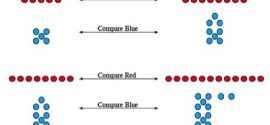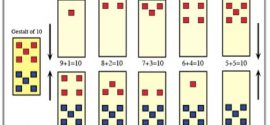Math Introduction
Since the YCDC website began in 2007, we have received many requests about how best to help dyslexic students struggling with math. We reached out to Chris Woodin, the head of the Math Department at Landmark School, a respected school that specializes in teaching students with language-based learning issues, to help us find alternative methods for mitigating common math struggles that seem to accompany dyslexia. Woodin offered many helpful strategies to help address them, and we hope that it will help other teachers and parents who are looking for ways to support dyslexic children with math. We also hope that if you are a math specialist or a parent of a child who has struggled in math, you will share what has worked for you.
Breaking Down Math
Excelling at math, or just even being able to pass the requirements, draws on many different skills and ways of thinking—it calls on conceptual, logical, and spatial reasoning, but it also often requires neatness, exactness, and computational skills. There are many areas in which to shine in mathematics, but unfortunately, there are also many areas in which to struggle. These tasks change over time, demanding increased refinement or elaboration of skill sets, or the addition of new ones as a student progresses through school. Woodin encourages teachers to treat math problems with the same kind of thoughtful and targeted strategies that are applied to reading instruction.
In the classroom, we break down the complex processing tasks of reading and spelling into various subskills that can be tested and analyzed. As a result, students’ strengths and weaknesses may be acknowledged and an effective course of action can be planned and implemented. Math skills, however, are not routinely evaluated in this manner. Math is usually assessed in terms of achievement: a student’s ability to perform a set of increasingly sophisticated computations or word problems. Resulting scores define students as being “good, average, or bad” at math. The problem with these labels is that, much like reading and writing, math is made up of subskills, and it may be that a deficiency in just one of these subskills makes the student “bad” at math. A student who is a poor speller or has bad handwriting wouldn’t necessarily be considered a poor writer. Specific weaknesses are not defined within the context of math, therefore specific therapies are not prescribed to treat them. In the math sphere, the “bad” math student who has been defined in very general terms is usually afforded an equally general course of remediation, and a repetition of previously introduced material ensues, or perhaps an enhanced sensory diet of “slower and louder” is dispensed.
The Relationship Between Math and Language Struggles
We often define dyslexia as an “unexpected difficulty in reading”; however, a dyslexic student may also have difficulty with math facts although they are often able to understand and do higher level math quite well. The specific skills that an educational evaluation measures to determine where language glitches, both written and verbal, occur can also be helpful in predicting where math breakdowns might occur. Using this knowledge, we can also develop strategies to address an individual student’s struggles in math.
Math-specific skills, including the ability to recognize and relate quantities, should also be assessed and factored into the production of an effective program for students whose atypical learning profiles suggest the need for special attention.
Why and how should teachers use what they know about language remediation to address math problems?
Mutlistep tasks can be difficult for students who have trouble organizing, naming, or sequencing; however, experience has shown that these students can be helped by using instructional methods that forge meaning and context through physically organizing objects, naming the action, and writing the process down.
Students’ learning styles must be acknowledged through the development of strategies that compensate for their individual difficulties. Woodin has found that using activities that involve visualizing, walking, and talking out problems are effective in developing vocabulary, organizational skills, and oral and written output.
Overview: Importance of Integrating Visual and Language Systems
Like reading, math involves many cognitive processes or systems. Ideally, teachers should diagnose and treat math breakdowns with the same specificity and strategies they apply to language-based instruction. When math remediation is most effective and efficient, it employs the same best practices that are used to address reading struggles. We know that using hand motions when teaching songs or poems may be helpful since it provides cues and context clues that reinforce learning of the content. Likewise, the best math instruction utilizes student strengths to mitigate weaknesses, and uses context and the integration of multisensory techniques to help the student create meaning and improve memory.
Christopher has published The Landmark Method of Teaching Arithmetic ©1995 and several journal articles. His latest project, Multiplication and Division Facts for the Whole-to-Part, Visual Learner: An Activity-Based Guide to Developing Fluency with Math Facts, is currently in press and due to be released in 2012. This comprehensive text features the methodologies and many of the activities that are described on The Yale Center for Dyslexia & Creativity’s website. To learn more about Mr. Woodin and his work, please visit his page on the Landmark School website and his own website.
Related
Math: Processing Breakdowns
Students with slower processing speeds or executive-function problems are often no different from their peers in math proficiency in first and second grade; but as they confront multistep computations in upper elementary school tests, their scores tumble because they lack the skills necessary to produce organized, efficient output.
Read MoreMath: Naming Problems
Math-specific concepts seem to be particularly difficult to master. In addition to being abstract, these concepts contain terms that confound students with visual similarity or auditory similarity between homophones.
Read More
Math: Memory Challenges
Often an educational evaluation will describe a dyslexic student as having “low working memory.”
Read More
Math: Counting & Comparing
A common response to students who are having counting problems is to simply have them do daily counting practice; however, students with counting and comparing difficulties also benefit from practice that utilizes patterns and relationships.
Read More